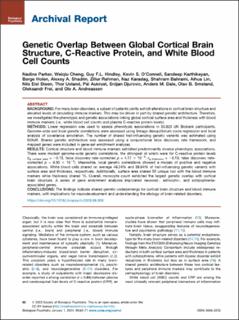| dc.contributor.author | Parker, Nadine | |
| dc.contributor.author | Cheng, Weiqiu | |
| dc.contributor.author | Hindley, Guy | |
| dc.contributor.author | O'Connell, Kevin Sean | |
| dc.contributor.author | Karthikeyan, Sandeep | |
| dc.contributor.author | Holen, Børge | |
| dc.contributor.author | Shadrin, Alexey | |
| dc.contributor.author | Rahman, Zillur | |
| dc.contributor.author | Karadag, Naz | |
| dc.contributor.author | Bahrami, Shahram | |
| dc.contributor.author | Lin, Aihua | |
| dc.contributor.author | Steen, Nils Eiel | |
| dc.contributor.author | Ueland, Thor | |
| dc.contributor.author | Aukrust, Pål | |
| dc.contributor.author | Djurovic, Srdjan | |
| dc.contributor.author | Dale, Anders | |
| dc.contributor.author | Smeland, Olav Bjerkehagen | |
| dc.contributor.author | Frei, Oleksandr | |
| dc.contributor.author | Andreassen, Ole | |
| dc.date.accessioned | 2024-01-17T12:23:27Z | |
| dc.date.available | 2024-01-17T12:23:27Z | |
| dc.date.created | 2023-09-06T08:43:32Z | |
| dc.date.issued | 2024 | |
| dc.identifier.issn | 0006-3223 | |
| dc.identifier.uri | https://hdl.handle.net/11250/3112161 | |
| dc.description.abstract | Background
For many brain disorders, a subset of patients jointly exhibit alterations in cortical brain structure and elevated levels of circulating immune markers. This may be driven in part by shared genetic architecture. Therefore, we investigated the phenotypic and genetic associations linking global cortical surface area and thickness with blood immune markers (i.e., white blood cell counts and plasma C-reactive protein levels).
Methods
Linear regression was used to assess phenotypic associations in 30,823 UK Biobank participants. Genome-wide and local genetic correlations were assessed using linkage disequilibrium score regression and local analysis of covariance annotation. The number of shared trait-influencing genetic variants was estimated using MiXeR. Shared genetic architecture was assessed using a conjunctional false discovery rate framework, and mapped genes were included in gene-set enrichment analyses.
Results
Cortical structure and blood immune markers exhibited predominantly inverse phenotypic associations. There were modest genome-wide genetic correlations, the strongest of which were for C-reactive protein levels (rg_surface_area = −0.13, false discovery rate–corrected p = 4.17 × 10−3; rg_thickness = −0.13, false discovery rate–corrected p = 4.00 × 10−2). Meanwhile, local genetic correlations showed a mosaic of positive and negative associations. White blood cells shared on average 46.24% and 38.64% of trait-influencing genetic variants with surface area and thickness, respectively. Additionally, surface area shared 55 unique loci with the blood immune markers while thickness shared 15. Overall, monocyte count exhibited the largest genetic overlap with cortical brain structure. A series of gene enrichment analyses implicated neuronal-, astrocytic-, and schizophrenia-associated genes.
Conclusions
The findings indicate shared genetic underpinnings for cortical brain structure and blood immune markers, with implications for neurodevelopment and understanding the etiology of brain-related disorders. | en_US |
| dc.language.iso | eng | en_US |
| dc.publisher | Elsevier | en_US |
| dc.rights | Navngivelse 4.0 Internasjonal | * |
| dc.rights.uri | http://creativecommons.org/licenses/by/4.0/deed.no | * |
| dc.title | Genetic Overlap Between Global Cortical Brain Structure, C-Reactive Protein, and White Blood Cell Counts | en_US |
| dc.type | Journal article | en_US |
| dc.type | Peer reviewed | en_US |
| dc.description.version | publishedVersion | en_US |
| dc.rights.holder | Copyright 2023 Society of Biological Psychiatry | en_US |
| cristin.ispublished | true | |
| cristin.fulltext | original | |
| cristin.qualitycode | 2 | |
| dc.identifier.doi | 10.1016/j.biopsych.2023.06.008 | |
| dc.identifier.cristin | 2172777 | |
| dc.source.journal | Biological Psychiatry | en_US |
| dc.source.pagenumber | 62-71 | en_US |
| dc.identifier.citation | Biological Psychiatry. 2024, 95 (1), 62-71. | en_US |
| dc.source.volume | 95 | en_US |
| dc.source.issue | 1 | en_US |

